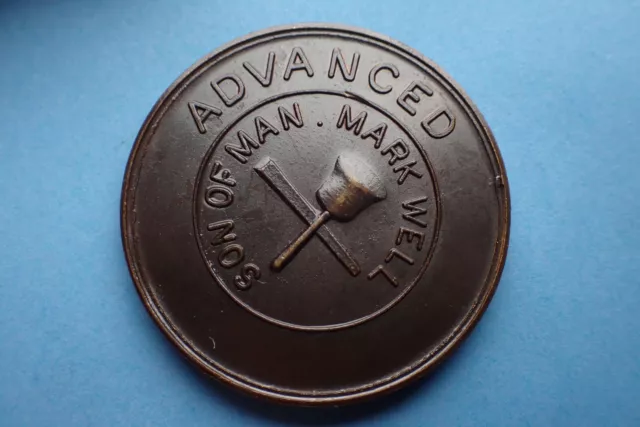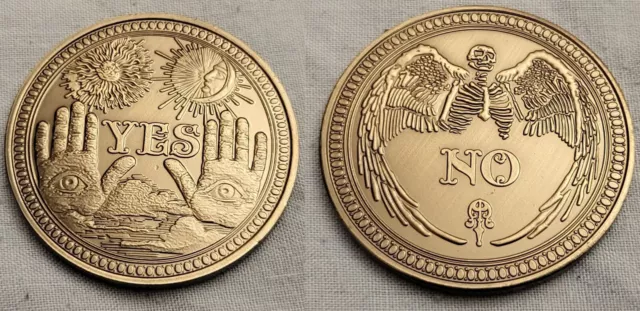Ja Nein Silbermünze Freimaurer Old Skelton Halloween Mond Hilf mir zu entscheiden Magie Retro
EUR 18,11 Sofort-Kaufen oder Preisvorschlag, EUR 6,96 Versand, 30-Tag Rücknahmen, eBay-Käuferschutz
Verkäufer: checkoutmyunqiuefunitems ✉️ (3.798) 99.9%,
Artikelstandort: Manchester, Take a look at my other items, GB,
Versand nach: WORLDWIDE,
Artikelnummer: 276416954032
Ja Nein Silbermünze Freimaurer Old Skelton Halloween Mond Hilf mir zu entscheiden Magie Retro. Yes or No Decision Coin This is a Dark Silver-Plated Coin One Side has the word "Yes" with Two Hands with Eyes like Freemason Symbols in the Sky is the Sun and the Moon The other side has the word "No" and a Skeleton with Wings Could be tossed when indecisive and whether the coin lands on yes or no will make the decision for you The Coin is 40mm in diameter and weights about an ounce The coin you will recieve would have never been taken out of air-tight acrylic coin holder Deluxe Coin Jewel Case. Would make an Magnificent Gift for any who is indecisive and will help them make big or small decisions In Excellent Condition Would make an Excellent Gift or Collectable Keepsake to Remember a Very Special Day Please Check out my other Mystery Items > Please CLICK HERE TO VISIT MY SHOP Bid with Confidence - Check My 100% Positive Feedback from almost 2,000 Satisfied Customers
| I have over 4 years of Ebay Selling Experience - So Why Not Treat Yourself? I have got married recently and need to raise funds to meet the costs also we are planning to move into a house together I always combined postage on multiple items so why not > Check out my other items ! All Payment Methods in All Major Currencies Accepted. All Items Sent out within 24 hours of Receiving Payment. Overseas Bidders Please Note Surface Mail Delivery Times > Western Europe takes up to 2 weeks, Eastern Europe up to 5 weeks, North America up to 6 weeks, South America, Africa and Asia up to 8 weeks and Australasia up to 12 weeks For that Interesting Conversational Piece, A Birthday Present, Christmas Gift, A Comical Item to Cheer Someone Up or That Unique Perfect Gift for the Person Who has Everything....You Know Where to Look for a Bargain!Please Take a Moment Click Here to Check Out My Other items *** Please Do Not Click Here *** Click Here to Add me to Your List of Favourite Sellers
If You Have any Questions Please Email Me thru ebay and I Will Reply ASAP Thanks for Looking and Best of Luck with the Bidding!!
|
- Condition: In Excellent Condition
- Composition: Metal
- Time Period: 20th Century
- Period: 21st Century
- Country/Region: British
- Country/Region of Manufacture: United Kingdom
- Country of Origin: Great Britain
PicClick Insights - Ja Nein Silbermünze Freimaurer Old Skelton Halloween Mond Hilf mir zu entscheiden Magie Retro PicClick Exklusiv
- Popularität - 1 beobachter, 0.1 neue Beobachter pro Tag, 9 days for sale on eBay. Normale beobachtend. 0 verkauft, 1 verfügbar.
- Bestpreis -
- Verkäufer - 3.798+ artikel verkauft. 0.1% negativ bewertungen. Großer Verkäufer mit sehr gutem positivem Rückgespräch und über 50 Bewertungen.
Die Leute Mochten Auch PicClick Exklusiv

Freemasons, Son of Man Mark Well Advanced Masonic Penny Token/Medallion.
EUR 17,42 Sofort-Kaufen 29d 11h
Sterling Silver Royal Masonic Hospital Jewel/Medal W Bro J.W.Gregory No4108
EUR 46,86 0 Gebote 3d 22h
hallmarked silver enamel london & provincial friendly society masonic jewel 1920
EUR 34,84 Sofort-Kaufen 16d 16h
Freemasons, Son of Man Mark Well Advanced Masonic Penny Token/Medallion.
EUR 17,42 Sofort-Kaufen 29d 11h
1964 Anniversary Fest Masonic Inst for Girls Steward Badge/Medal/Jewel by Gaunt
EUR 19,52 Sofort-Kaufen 19d 13h


